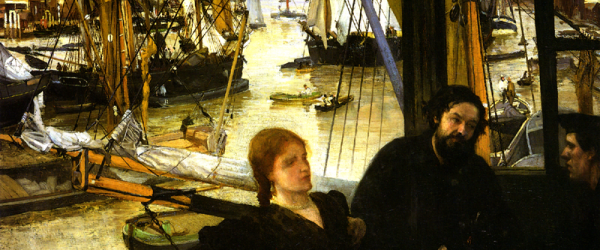
On some selected works of James McNeill Whistler
Art, Commentary, Culture, Essays“Death must be so beautiful. To lie in the soft brown earth, with the grasses waving above one’s head, and listen to silence. To have no yesterday, and no tomorrow. To forget time, to forgive life, to be at peace.”- Oscar Wilde, The Canterville Ghost
An unimpressed Ruskin, after viewing Whistler’s Nocturne in Black and Gold- The Falling Rocket (c. 1875), accused the painter of merely “flinging a pot of paint in the public’s face” with this unconvincing depiction of firework display amidst a foggy night sky. Whistler, duly exasperated, quickly sued the art critic for libel. In what followed as probably one of the most famous trials in the history of art- I doubt there’ve been many – the defamed artist won the lawsuit, and yet it was only a pyrrhic victory. Whistler was awarded a mere farthing in nominal damages- an even greater ignominy for one who squandered half of his fortune to reclaim his dignity and reputation. He soon thereafter faced long years of bankruptcy.

Despite Ruskin’s overt incredulity of Whistler’s capacity as an artist, to any indiscriminate eye the artist’s singular talent is of little doubt. Throughout his career Whistler had been aiming for a perfect parallel and consonance between music and art, the two that seemingly so compatible with each other, but are in fact so difficult to be coaxed into unequivocal affinity. Not many of us are capable of comprehending music with the aid of painting, or vice versa. Most of us simple minds are usually so dull and unimaginative that we need everything to be transparently articulated so we can fully understand the meanings. How often are our interpretations of a painting informed by its title? Therefore I suppose the purpose with Whistler’s peculiar designation of his paintings (most of which were entitled “arrangements,” “symphonies” or “harmonies”) was to prompt the viewers to ponder on the harmony of music and art, instead of taking for granted the perceived subject matter. Without indicating that such and such are “symphonies” or “arrangements,” it is very likely that those paintings are to be regarded by many as yet another portrayals of ordinary people doing ordinary things.
The music in Whistler’s paintings is usually in mild tempo, gentle flow, very rarely happening on any choppy waves. Even in its most violent we feel that the sound is loud and strong but by no means overbearing. Occasionally, we hear silence. The water can be so still and placid; the ruffles of a lady’s skirt so resistant to the sway of the winds. There underlies every piece of Whistler’s oeuvre a serene, elegant beauty.
In Symphony in Flesh Colour and Pink: Portrait of Mrs. Frances Leyland (1872-3), the colours of the lady’s dress and that of the background are almost identical. What one sees, at one point, as a pleasing effect of tonal harmony, turns into an impression of dreary and unnerving the next. We sense a gradual and peculiar blending-in of the figure with its background. With her head slightly turns towards the viewers we see, written vividly on her face, that of unaccountable sadness and weariness. Elegance proves to be merely a semblance of life, beneath which banality locks up the lady’s soul to frost. She appears to be even more lifeless than the white blossoms, the presence of which she listlessly regards. We are not looking at a portrait of Mrs. Leyland. More likely we are looking at a still-life.

Whistler’s people are rarely in a good mood. In any frozen moment they often appear pensive and troubled. In Wapping (1861), we seem to see a precedent of Degas’s L’ Absinthe (1876). The men chat away whilst the woman looks on, unamused and detached. In her furrowed brows we read self-alienation; we discern the disenchantment with life frittering away in meaningless leisure. She suffers within herself a slow death, a barely perceptible process of decaying. Following her hand that tightens around the rail- some might want to interpret it as a silent call for help- there reveals a splendid view of harbor. The ships and water are bathed in yellow sunlight. All are abuzz in preparation for a glorious day of sail. Again, there is a marked contrast between the liveliness of the background and the inanimatedness of the figures.

We viewers cannot resist asking: what is troubling those people? What is the cause of this nameless malaise? The tranquil beauty of Whistler’s paintings, engendering mostly from the prevailing use of pearl-like colours and elegant contours, is nonetheless undercut by a mounting feeling of gloominess. Time dutifully ticks by just as any other day. The lives of the people trudge on in the wake, only reluctantly. How they wish the day could just halt to a frozen point! Ruddiness will bleed out of the cheeks of those beautiful people. They are the phantoms, roaming the world like mists upon a lake.
In Nocturne: Blue and Gold- Old Battersea Bridge (1872-5), time is now the formidable bridge that watches on whilst a lone figure, rendered small, wades through the water. Life is weighing heavily upon the back of the person, but, unlike most of Whistler’s characters, he does not cravenly flee from responsibility by transforming into yet another unfeeling phantom. Death is beautiful but life is the reality. To be alive is to hear that subtle palpitation of heart, however small the sound is comparing to the deafening howls of the river, the thunder, nature, and to know that one’s existence is equally significant as everything else. The lone figure, hastening on to his destination, hears it all.























